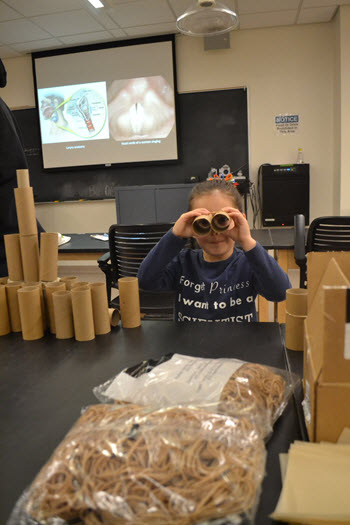
“I can’t believe math was this exciting.”
“Remember the rock activity? I want to go into that.”
“Cells. I want to learn more when I’m in college.”
Kaur was thinking, “This was something I would have liked to have done when I was a child.”
A native of India who arrived in Turlock as a 10-year-old, Kaur didn’t attend this annual event devoted to inspiring young people to pursue STEM studies, but she managed to find her way into the curriculum nonetheless. She worked at Science Day all four years she was a biology major at Stan State and as she awaits acceptance at medical school, she’s serving as a CSU STEM VISTA staff member in the Office of Service Learning and will volunteer again when the ninth annual Science Day takes place from 10 a.m.-2 p.m. on Saturday, March 7.
Kaur will be joined by some 300 Stan State students as well as faculty and staff volunteers at the event, which started in 2012 and has grown to attract more than 3,000 science enthusiasts of all ages.
“Commencement is the only other event that brings more people to campus than Science Day,” said event founder Mark Grobner, professor of biological sciences.
Smaller groups of children attend Science Saturday on campus throughout the year, but Science Day is an enormous undertaking of Stan State’s Science in Our Community program, responsible for STEM Ambassadors, Junior Scientists and other outreach to students and the community.
“It’s not just kids that the day means so much to,” said Stan State student Christian Pagala, who will graduate in May and has volunteered at Science Day since 2017. “It’s parents and older kids who’ve done it in the past and come back to see if there’s anything new. I’ve seen a 60-year-old man and his wife get excited about something. This is about the entire community.”
It started as a simple celebration of science in 2012, a collaboration between Grobner, then the chair of the Biology Department, and Julie Fox, director of the Office of Service Learning. He came up with activities. She handled the logistics.
Since that first effort, Science Day has grown in scope and popularity.
This year’s edition will invite visitors into Naraghi Hall of Science, the Science 1 Building, the Trans-California Pathway, the Greenhouse and the Sustainable Garden. They can even walk through a huge model of a human heart, courtesy of Emanuel Hospital, or visit the mobile displays of the Turlock Irrigation District and the National Ag Science Center. They can see a snake and bearded lizard or look through a solar telescope, and — courtesy of the Chemistry Department — use a magnet to see exactly how much iron is in their breakfast cereal. Biology labs and classrooms will be open for hands-on experiments and lessons in STEM-related fields.
The cell lab is always popular, Grobner said, as is the math room with its games and puzzles, according to Miriam Ureno Moreno, who volunteered at Science Day as one of Grobner’s health studies students and now helps as a staff member in the Office of Service Learning.
Math, specifically working as a math tutor, is what first drew Pagala to Science Day in 2017, when the math tutors signed on collectively as volunteers.
Pagala, from Stockton, decided to pursue a career as a science teacher after his experience as a tutor. He’s practiced in the classroom at Science Day, teaching a lesson using small robots trained to react to color patterns.
“The first time was nerve-wracking,” Pagala said. “I wanted everything to go perfectly, but I learned that never happens. After the first activity, the nerves started to get shaken out. I was getting a rhythm. It was a new experience because I was seeing different students with every new group. It’s such a wonder to do the same thing over and over, but still be excited every time.”
Junior psychology major Edith Cisneros is about to volunteer at Science Day for the first time, and although she’s a STEM Ambassador and has frequently helped small groups of youth engaged in activities such as making robots or slime at Science Saturdays, she doesn’t want to lead a lesson.
“I like to help with the activities and for me, it’s mainly about working with children,” Cisneros said. “I want to be a pediatric oncology nurse, so experiences like this are good. I love kids. I love the sciences. This will be fun.”
The stories of Pagala and Cisneros epitomize the real value of Science Day.
“Not only are we reaching out to the community, but we take into consideration our students and the experience they get out of it,” Ureno Moreno said.